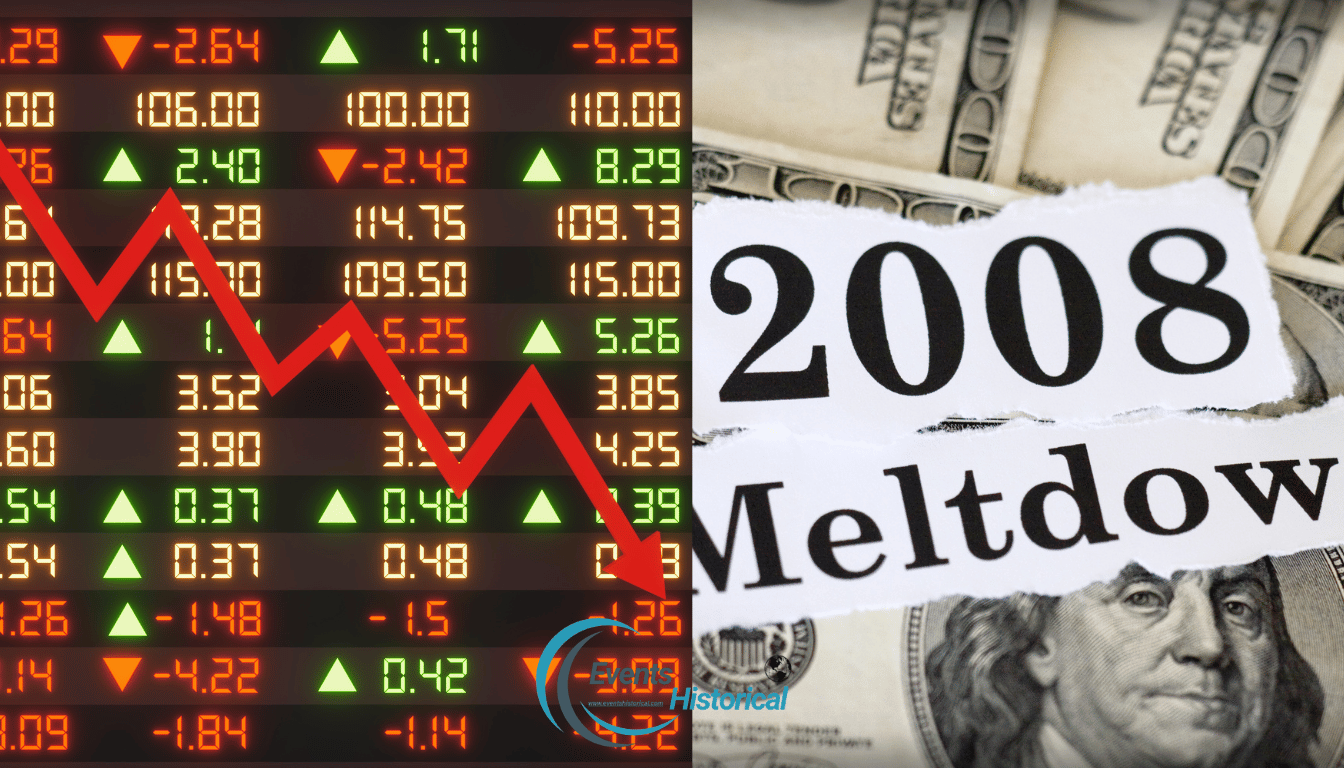Explore the origins, repercussions, and revival from The 2008 Global Financial Crisis: Causes, Effects, and Economic Recovery.
Imagine if the actions that made the housing market soar were the same ones that caused it to crash. The 2008 global financial crisis was a mix of risky banking, failed regulations, and poor management. It led to a deep economic downturn, known as the Great Recession. This crisis changed the financial world, causing millions to lose their jobs and needing huge bailouts.
We will explore the complex factors that led to the 2008 financial crisis. We’ll look at the events before, the causes of the collapse, and its lasting effects on the world’s economies. Learning from this moment in history helps us avoid future crises.

Key Takeaways
- The 2008 global financial crisis was marked by a peak in housing prices followed by a dramatic collapse.
- Mortgage debt soared to alarming levels, reaching 97% of GDP by 2006.
- Unemployment spiked to 10%, doubling the pre-crisis rate.
- Governments enacted significant stimulus measures, including an expenditure of $787 billion in the U.S.
- Recovery from the Great Recession was slow, with GDP growth averaging only 2% during the four years following the crisis.
- The failure of Lehman Brothers in September 2008 triggered a global panic.
- Regulatory reforms were implemented post-crisis to enhance oversight of financial institutions.
The Prelude to the 2008 Global Financial Crisis
The years before the 2008 Global Financial Crisis saw a unique economic climate. This climate led to a sharp increase in housing market activity. The U.S. economy was booming, with low unemployment and easy borrowing.
Low interest rates and growing wealth made people eager to take out mortgages. Mortgage borrowing nearly doubled from 61% of GDP in 1998 to 97% in 2006.
The Economic Climate Leading Up to the Crisis
The economic climate was vibrant, drawing many into the housing market. The Federal Reserve’s decision to lower interest rates made borrowing easier. Mortgage rates hit a record low, making credit accessible to many.
The Boom in Housing Market Activity
The housing market activity surged, fueled by optimism. Home prices reached historic highs in 2006. This boom led to a housing bubble.
Lenders took on too much risk, especially with subprime mortgage crisis borrowers. Defaults rose as adjustable rates kicked in, setting the stage for a major economic downturn.

| Factor | Details |
|---|---|
| Mortgage Borrowing | Increased from $200B annually in the mid-1990s to $1T from 2003 to 2006 |
| Interest Rates | Federal Reserve lowered rates from 6% to 1% between 2001 and 2003 |
| Home Prices | Peaked in 2006 at nearly twice the long-term average price |
| Subprime Mortgages | Extended to borrowers unable to sustain payments as rates adjusted |
Main Causes of the 2008 Global Financial Crisis
The 2008 Global Financial Crisis was caused by several key factors. Financial institutions took on too much risk, leading to a big economic problem. They gambled with mortgage-backed securities without checking their safety, causing financial trouble.
This risky behavior mainly came from giving out mortgages without checking if people could pay them back. It created a risky situation for both lenders and borrowers.
Excessive Risk-Taking by Financial Institutions
Financial institutions took too many risks during this time. They gave out subprime mortgages to people with bad credit, leading to more risky loans. These risky loans were then packaged into mortgage-backed securities.
Investors trusted these securities, not knowing the risks they held. This lack of understanding led to a big crisis when defaults started to rise.
Increased Borrowing and High Leverage
Borrowing went up as financial institutions used a lot of debt to make money. They relied too much on debt, making them more likely to lose money when the housing market fell. Easy credit let people buy homes they couldn’t afford, making the system more unstable.
When housing prices dropped, many couldn’t pay their loans. This led to a chain reaction of defaults that hurt the whole economy.
Regulatory Failures and Policy Errors
Regulatory failures were a big part of the crisis. Agencies didn’t keep up with the fast growth of subprime lending. Old rules and weak enforcement let financial institutions take too many risks.
Without strict rules for mortgage-backed securities, policymakers missed the danger of rising defaults. This mistake helped bring down many financial institutions and made the crisis worse.

The 2008 Global Financial Crisis: Causes, Effects, and Economic Recovery
The 2008 financial meltdown was a major turning point in global economics. It was caused by risky actions by banks, high borrowing, and failed regulations. These factors led to huge job losses and a big drop in people’s wealth worldwide.
Since 2007, global debt has grown to about $72 trillion. This shows the big challenges faced after the crisis. Corporate debt in countries like China has also increased a lot, raising worries about defaults.
Household debt has shown different trends in different places. Some countries, like the US and UK, have cut their debt levels. But others have not, showing different recovery paths. The crisis had a big impact, with a recession lasting from 2007 to 2009.
After the crisis, governments tried to get economies going again. They used low interest rates and spending to help. But, many economies took years to get back to where they were before, showing how hard recovery can be.
How the Crisis Unfolded
The 2008 financial crisis started with a big drop in house prices. This led to many homeowners not being able to pay their mortgages. The problem was worse for those who had taken out risky loans.
This first problem caused a big chain reaction. It affected banks and financial markets all over the country.
The Fall of House Prices and Rising Defaults
House prices started falling around 2006. This made it hard for homeowners to keep up with their mortgage payments. Many homeowners had to default on their loans.
Subprime lenders, like New Century Financial, had given out a lot of loans in 2006. This made many people vulnerable to financial problems. By 2007, over 25 subprime lenders had gone bankrupt.
The Stress in Financial Markets and Banking System
As more people couldn’t pay their mortgages, the financial markets started to suffer. The Securities and Exchange Commission had relaxed rules in 2004. This allowed banks to take on too much risk.
By 2007, the stock market was losing a lot of value. Banks were struggling to stay liquid and were facing huge losses.
Panic Following Lehman Brothers’ Collapse
On September 15, 2008, Lehman Brothers went bankrupt. This event caused widespread panic. It made everyone question the stability of big banks.
After Lehman Brothers’ bankruptcy, banks stopped lending. Investors lost trust, leading to a huge crisis.
| Event | Date | Impact |
|---|---|---|
| Start of housing price decline | 2006 | Increase in mortgage defaults |
| Bankruptcy of major subprime lenders | Early 2007 | Loss of financial security for borrowers |
| Lehman Brothers’ collapse | September 15, 2008 | Global financial panic and credit market freeze |
| Unemployment peak | 2010 | 10% unemployment rate |
| TARP intervention | 2008 | $440 billion government spending |
Effects of the 2008 Financial Meltdown
The 2008 financial meltdown had a big impact on the world’s economies. It caused severe drops in many countries. Financial systems that were connected worldwide suffered, affecting many nations.
Impact on Global Economies
Big financial institutions lost a lot of value, causing widespread instability. The stock market crash of 2008 hit many sectors hard. This led to big drops in GDP, like a 4.3% fall in the U.S. during the Great Recession.
Latvia saw an even bigger drop in GDP, over 25%.
Job Losses and Economic Slowdown
The financial crisis hit jobs hard. In the U.S., over 8.7 million jobs were lost. This made unemployment jump from 5% to 10%.
The economic slowdown also raised the poverty rate. It went from 12.5% in 2007 to over 15% by 2010. Child poverty also increased.
Stock Market Crash and Wealth Loss
The 2008 stock market crash caused huge wealth losses for many American families. It erased an estimated $16 trillion in net worth. The S&P 500 index plummeted by 57% between 2007 and 2009.
Wealth became more concentrated. The richest 7% of U.S. households saw their wealth jump by 28% in the first two years after the crisis. But the other 93% saw their net worth drop by 4%.
| Metric | Before Crisis | During Crisis | After Crisis |
|---|---|---|---|
| Unemployment Rate | 5% | 10% | Continued fluctuations |
| Poverty Rate | 12.5% | 15% | Persisted at elevated levels |
| S&P 500 Index Drop | N/A | 57% | Gradual recovery |
| Net Worth Loss | N/A | $16 trillion | Recovery for affluent households |
Policy Responses to the Financial Crisis
The 2008 financial crisis led to a mix of actions. These included aggressive monetary policies, big fiscal boosts, and new rules to avoid future problems. The goal was to make the economy stable and get people to trust the financial system again.
Monetary Policy Measures: Low Interest Rates
The Federal Reserve took bold steps to fight the economic downturn. They lowered interest rates to almost zero to encourage people to borrow and invest. They also bought mortgage and government debt to add money to the economy.
This helped the economy slowly get better. It made financial markets more stable.
Fiscal Stimulus and Government Interventions
The $787 billion American Recovery and Reinvestment Act was a big fiscal push. It was one of the biggest in U.S. history. It aimed to increase economic activity and reduce job losses.
The Troubled Asset Relief Program (TARP) gave $700 billion to help struggling banks. These efforts were to help the economy recover and create jobs after huge job losses in 2009.
Regulatory Changes: Dodd-Frank Act and Oversight Enhancements
The Dodd-Frank Wall Street Reform and Consumer Protection Act was passed in 2010. It was a key change in regulations. It aimed to improve oversight in the financial sector by merging agencies and tightening rules on derivatives.
The Financial Stability Oversight Council was set up to watch for risks in banking and finance. It was to make the system more accountable and transparent. It aimed to fix the problems that led to the 2008 crisis.
Economic Recovery Post-2008
The 2008 financial crisis hit economies hard worldwide. The United States faced a slow recovery, with slow job growth and a slow increase in GDP. It took years for the economy to fully bounce back.
Slow Recovery: Employment and GDP Growth
After the recession, the U.S. economy grew slowly. Real GDP growth averaged about 2% in the first few years after the crisis. It didn’t reach its pre-crisis level until 2017, showing the crisis’s lasting effects.
Job numbers were also slow to recover. Unemployment hit 10 percent in October 2009 and didn’t return to pre-crisis levels until 2015. This slow recovery affected many sectors, impacting overall economic confidence and spending.
Long-term Effects on the Financial Sector
The financial sector learned hard lessons from the crisis. New regulations were put in place, changing how financial institutions operate. Banks and other financial companies now focus more on managing risks.
Financial products were also reviewed closely, leading to changes in how they are made and sold. The goal was to avoid the risky behaviors that caused the crisis. Today, the financial sector operates under strict rules, focusing on transparency and accountability.
| Year | Real GDP Growth (%) | Unemployment Rate (%) |
|---|---|---|
| 2009 | -4.3 | 9.5 |
| 2010 | 2.6 | 9.6 |
| 2015 | 3.1 | 5.0 |
| 2017 | 2.4 | 4.8 |
Global Recession Aftermath
The global recession after the 2008 crisis had big effects on many areas. The economic downturn changed financial markets and policies worldwide. Countries struggled with high debt and slow growth.
The Great Recession lasted from December 2007 to June 2009. In the U.S., the GDP fell by 4.3%. The unemployment rate hit nearly 10%. The Dow Jones lost over half its value.
Households and non-profits saw their net worth drop from $69 trillion to $55 trillion in 18 months. This was a huge loss.
It became clear that strong rules were needed for growth. Lessons were learned about managing risks. But, some countries like China and India kept growing thanks to their policies.
Global institutions and governments looked at their plans again. They wanted to be ready for future downturns. The recession’s effects still show in our economy, reminding us of its dangers.
| Indicator | Before the Recession | During the Recession |
|---|---|---|
| GDP Decline | NA | -4.3% |
| Unemployment Rate | 5% | 10% |
| Dow Jones Industrial Average | 14,000+ | 6,547 |
| Net Worth of Households | $69 trillion | $55 trillion |
Conclusion
The 2008 Global Financial Crisis was a major turning point in economic history. It showed us how fragile our financial systems can be. The crisis led to the loss of about 8.8 million jobs and pushed unemployment to 10% by October 2009.
Home prices fell by 40% on average, causing over eight million foreclosures. This resulted in a huge loss of $17 trillion in household wealth. These numbers remind us of the crisis’s impact and urge us to strengthen regulations and monitoring.
After the crisis, policymakers and institutions learned a lot. They made big changes in how they watch over the economy. Laws like the Dodd-Frank Act were created to make financial companies more responsible.
It’s key to understand the balance between risk and reward to keep the economy stable. The world’s economies are always changing, and we must be ready.
The Great Recession taught us about the dangers in our financial systems. It showed us the importance of being careful and prepared. By using what we learned, we can build a stronger economy that can handle market ups and downs.
FAQ
What were the main causes of the 2008 Global Financial Crisis?
The crisis was caused by banks taking too many risks and borrowing too much. Also, rules were too weak, letting bad lending happen, especially in subprime mortgages.
How did the housing market contribute to the financial crisis?
The housing market created a bubble with high prices and reckless loans. When interest rates went up, many couldn’t pay their mortgages, making the crisis worse.
What effects did the 2008 crisis have on global economies?
The crisis caused big drops in the economy worldwide. Countries faced high joblessness, lost wealth from stock market crashes, and slow growth.
How did government respond to the 2008 financial crisis?
Governments used new money policies and big spending plans to help. They cut interest rates, bought bonds, and passed the American Recovery and Reinvestment Act to boost the economy.
What were the long-term impacts of the 2008 financial crisis on regulation?
The crisis led to big changes in banking rules, like the Dodd-Frank Act. These changes aimed to stop future crises and make financial markets clearer.
Why did the stock market crash during the 2008 financial meltdown?
The stock market fell because of panic after Lehman Brothers failed. Fears of bank failures led to a huge drop in investor confidence, losing trillions in value.
What was the role of subprime mortgages in the financial collapse?
Subprime mortgages were key by letting people with bad credit get loans. When housing prices dropped, these loans defaulted, causing financial instability.
What strategies were employed for economic recovery post-2008?
Recovery plans included easier money, big spending, and new banking rules. But, the recovery was slow and uneven.
How did the 2008 Global Financial Crisis impact employment levels?
The crisis cost over 8.7 million jobs in the U.S., raising unemployment to around 10%. It took years for jobs to get back to normal.
What lessons were learned from the 2008 financial crisis?
The crisis showed the need for strong rules, careful risk-taking, and understanding financial markets. It taught policymakers to make financial systems strong against future shocks.

